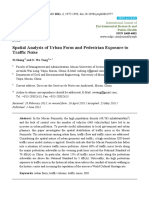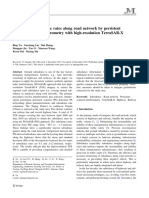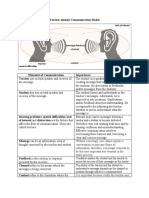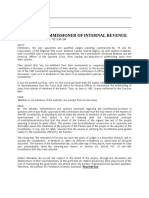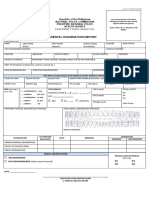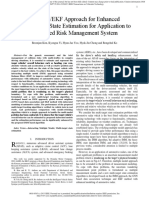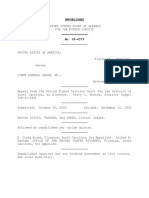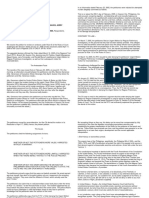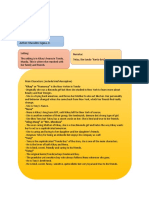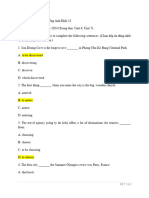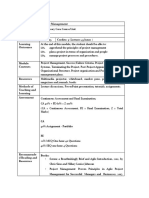Ijesca: Factors Affecting Traffic Noise Based On Road Environment Aspects
Ijesca: Factors Affecting Traffic Noise Based On Road Environment Aspects
Uploaded by
nejra_bluCopyright:
Available Formats
Ijesca: Factors Affecting Traffic Noise Based On Road Environment Aspects
Ijesca: Factors Affecting Traffic Noise Based On Road Environment Aspects
Uploaded by
nejra_bluOriginal Title
Copyright
Available Formats
Share this document
Did you find this document useful?
Is this content inappropriate?
Copyright:
Available Formats
Ijesca: Factors Affecting Traffic Noise Based On Road Environment Aspects
Ijesca: Factors Affecting Traffic Noise Based On Road Environment Aspects
Uploaded by
nejra_bluCopyright:
Available Formats
International Journal of Engineering and Science Applications
ISSN: 2406-9833 @2015 PPs-UNHAS
IJEScA
Factors Affecting Traffic Noise
Based On Road Environment Aspects
Irwan Lakawa1*, Lawalenna Samang2, Mary Selintung2, and Muralia Hustim3
1
Doctoral Student at Civil Engineering Dept., Hasanuddin University, Indonesia
2
Professor, Civil Engineering Dept., Hasanuddin University, Indonesia
3
Lecturer, Civil Engineering Dept., Hasanuddin University, Indonesia
*
email: ironelakawa@gmail.com
ABSTRACT
The purpose of this study is to analyze factors affecting traffic noise on arterial and collector roads
in Kendari. The factors are road environment aspects, including building density, tree density, leaf
lush volume, types of road environment ground surface, as well as temperature. Analytical
approach with simple and multiple regression methods was used with SPSS software ver. 22.0. The
results show that based on the determination coefficient, partially, tree density has the highest
effect by 19%, then leaf lush volume 9.7%, temperature 9.1%, building density 8.7%, and types of
road environment ground surface 5.8%. However in this study, the factors significantly affecting
the noise are only tree density, leaf lush volume, and temperature. It is based on the value of sig-
< 0.05. Simultaneously, the variability of noise levels can be explained by the variables of tree
density, leaf lush volume, and the air temperature by 31.1%, while 68.9% is explained by other
factors not examined in this study
Keywords: factors; effects; road environment; noise
Article history: Received 20 September 2015, last received in revised 11 Ocktober 2015
1. INTRODUCTION order to reduce traffic noise are performed.
TRAFFIC noise is a problem that To provide a comprehensive solution, it is
cannot be avoided due to interacting first necessary to understand the factors that
transportation system. The problem currently can affect the level of noise.
happens in big cities and medium-sized cities Several studies have examined the
around the world, including Indonesia. At factors affecting the level of noise from the
certain intensity, the traffic noise can be bad traffic aspects, among others; prediction and
for humans because it can disrupt the health simulation models of traffic noise based on
and comfort of people in the surrounding groups of vehicles divided into 8 groups: bus,
settlements and road users. The disruption can car, double cabins taxi, jeeps, trucks,
be psychological disorder that tends to lead to motorcycles, three-wheeled vehicles, and
stress and hearing loss. vans. However, this model is only used for a
Therefore, in any activities in the field steady flow of traffic condition with the
of traffic and road transport, it should be assumption that the movement of traffic is
performed prevention and control of free without any obstruction such as zebra
environmental pollution to comply with crossing or traffic light [2]. Traffic noise
environmental quality standards [1]. The prediction model can be used effectively
question now is how the control measures in under the conditions of the cities in Iran. The
IJEScA vol. 2, 2, November 2015 117
International Journal of Engineering and Science Applications
ISSN: 2406-9833 @2015 PPs-UNHAS
IJEScA
variables used include the total volume of environment parameters, weather parameters,
vehicles, speed, percentage of truck vehicles, and residence parameters [8]. The study of
length and width of road, Gradients, and factors affecting the noise in a region is not
observation distance. The measuring distance only seen from the aspects of traffic, but it is
of noise from the road side is 3m [3]. also required a study of road environment
Simple and multiple regression model aspect. Therefore, later it can be used as
of local traffic effects on noise levels for information in the handling of noise either in
arterial roads in Bali with the locus of Ngurah source or propagation path of the noise.
Rai By-Pass and Sunset Street used 2. MATERIALS AND METHODS
independent variable of traffic volume (MC, A. Research Location
LV, HV), speed (MC, LV, HV) , and distance The research was conducted in
from observation point to the nearest and Kendari, Southeast Sulawesi (Indonesia) with
furthest center line [4]. From the results of the locus of arterial and collector roads
another study, effects of the green system on becoming a major center for the movement
the noise level in three landscape conditions: of traffic including public transport
tree plants, shrubs, and trees-shrubs distribution channels. The selection of
combination, a combination of trees and Kendari as the research location because this
shrubs with average leaf lush of 75% evenly city was one of the medium-sized cities with
distributed from ground level to a height of 5 the characteristics of heterogeneous traffic, in
meters can reduce the noise by 8.2 dBA, or which the growth rate of motor vehicle was
about 25% [5]. The composition of vegetation quite high, at an average of 19% per year.
consisting of trees, shrubs and bushes can
reduce noise up to 12.25% and decrease the
temperature to 8.18% [6].
Noise characteristics of a road should
be different with the characteristics of noise
in another way. This difference occurs
because the traffic noise level is determined
by many factors, such as motor vehicles
passing through (number of vehicles, types of
vehicles, average speed of vehicles),
characteristics of the road, and other
conditions in the surrounding road [7]. Traffic Figure 1. Location and Point of Research
noise is influenced by a number of parameters Sample
that do not depend on the vehicle itself, such
as; traffic parameters, road parameters,
IJEScA vol. 2, 2, November 2015 118
International Journal of Engineering and Science Applications
ISSN: 2406-9833 @2015 PPs-UNHAS
IJEScA
B. Data Collection performed on each observation segment
The number of observations sample along 25m. Percentage of building density
were 49 points on arterial and collector roads. was calculated by the equation:
Criteria for determining the sample point
used incidental sampling technique by
Dbg = x 100%
considering the function of road and
(2)
environmental conditions of the road.
Surveys of noise and temperature were
Where, Dbg is building density (%), Ldi is
conducted for 10 minutes at each observation
width of buildings walls (m), Ps is
sample point. SLM microphone was placed
observation segment length (m). Tree density
at a distance of 6m from the edge of
was calculated by the equation:
pavement. To obtain the value of equivalent
continuous noise level (Leq), it was calculated DPh = x 100%
by the following equation [7] [8]: (3)
Leq = L50 + 0,43 (L1 – L50) Where, Dph is tree density (%), Pki is width of
(1) leaf canopy (m), Ps is observation segment
length (m). Leaf volume calculation used the
Where, Leq is equivalent continuous noise equations in Table 1 [9].
(dBA), L50 is noise exceeded 50%, and L1 is
noise exceeded 1%.
Table 1. Leaf Lush Volume Based on
Canopy Shape
Figure 2. SLM Placement Scheme
Types of environmental surfaces Leaf volume in Table 1 applied to the
between road side and buildings (yard) were leaf lush percentage of 100%. If less than
identified according to the types of surface 100%, then the leaf volume was multiplied
namely; (1) grass, (2) land, (3) paving-block, by the percent value of the leaf lush in Figure
(4) concrete rebates. The identification was 3.
IJEScA vol. 2, 2, November 2015 119
International Journal of Engineering and Science Applications
ISSN: 2406-9833 @2015 PPs-UNHAS
IJEScA
value, it turns out that the building density
and type of ground surface road environment
are not significant because p-value is > 0.05.
Most relationship between predictor variable
and response are non-linear. Multiple-
regression model used several predictor
variables and one response variable. The goal
Figure 3. Estimated Leaf Lush Percentage
was to determine the effects of predictor
variable simultaneously. Based on the output
3. RESULT AND DISCUSSION
of Table 2, the variables used were the
Variables becoming the predictor
variable having significant value (p-value) <
consisted of; building density (Dbg), trees
0.05, they were; tree density (Dph), leaf lush
density (Dph), leaf lush volume (Vda), types of
volume (Vda), and temperature (Su).
road environment ground surface (Pbu),
temperature (Su). These were independent Table 3. Multiple Regression Model
variables constituting component forming the
model. The response variable was the noise
level (NL). Analytical approach in
determining the factors affecting noise used
statistical method of simple and multiple-
Table 3 showed the alternative models
regression with SPSS ver. 22.0.
of multiple regression analysis.Therefore, the
Simple regression analysis is a method
reflection effect of the building wall is almost
to determine the partial effects of each
non-existent, similarly in the type of ground
predictor variable on the response variable.
surface, on which the number of observation
The effects of the variables were seen from
samples that do not have obstacles such as
the probability of significance and coefficient
trees are only 18% of the total sample. It is
of determination (R²). The confidence level
possible that this is the cause of the
used was 95%, meaning the significance
relationship between ground surface type and
value (p-value) less than or equal to 5%, and
noise not significant.
had a coefficient close to 1 (R² ≈ 1).
The analysis results in Table 2 show Table 2. Model and Effects of Partial
Variables
that the tree density has the highest effect,
that is by 19%, then leaf lush volume 9.7%,
temperature 9.1%, building density 8.7%, and
type of ground surface road environment 5.8
%. However, if seen from the significance
IJEScA vol. 2, 2, November 2015 120
International Journal of Engineering and Science Applications
ISSN: 2406-9833 @2015 PPs-UNHAS
IJEScA
Based on the examination of statistical assumption tests are, among others:
parameters in Table 3, the selected model is normality, heteroscedasticity,
number 2 because it meets all the test multicollinearity, and autocorrelation.
parameters, namely; Fcount 3.15 > Ftable 2.81, In Table 4 it can be seen that all the
standard error of the estimate 0.00 < standard variables have the value of asymp. sig-KS >
deviation of 0.14, sig (p-value) 0.023 < 0.05, 0.05, meaning that the data are relatively
and determination coefficient of 31.1%. equal to the average, so it can be said that the
Although the building density and the type of residual meets the normality assumption.
road environment ground surface does not Detection of the presence of multi-collinearity
have significant effect in this study, based on symptoms can be seen from VIF value. It is
the study of theory, the two variables affect said there are no multi-collinearity symptoms
the noise level. This is possible because in if VIF < 10. In Table 5, the VIF value of Dph,
this study, the distance between front building Vda, and Su variables are smaller than 10,
wall and sound level meter (SLM) varies, of meaning that there are no multicollinearity
which approximately 70% have the distance symptoms. Independency test aims at
between 5-20 m. detecting the presence of autocorrelation
Therefore, the reflection effect of the symptoms by seeing the value of Durbin-
building wall is almost non-existent, similarly Watson statistics.
in the type of ground surface, on which the The requirement: du < DWcount < 4-du
number of observation samples that do not (du: upper limit of Durbin-Watson). The
have obstacles such as trees are only 18% of value of DWcount = 1.849 (output model
the total sample. It is possible that this is the summary). The value is in the required range,
cause of the relationship between ground so there are no autocorrelation symptoms.
surface type and noise not significant. Heteroscedasticity symptoms can be
Good or bad multiple linear regression determined by scatter plot diagram between
model has requirements that must be met, that NL predictive variable (Fits) and residual
is classical assumption. The classical variable.
Table 4. One-Sample Kolmogorov-Smirnov Test
IJEScA vol. 2, 2, November 2015 121
International Journal of Engineering and Science Applications
ISSN: 2406-9833 @2015 PPs-UNHAS
IJEScA
From Figure 4, it can be concluded that ground surface 5.8 %. However in this study,
there is no heteroscedasticity symptoms the factors significantly affecting the noise are
because the plots are evenly spread above only tree density, leaf lush volume, and
and below axis 0 without forming a specific temperature. It is based on the value of sig-α
pattern. < 0.05.
Tree obstruction is a factor that makes
it difficult to identify in detail the effects of
ground surface types on noise, because the
sound of vehicle received by SLM has been
absorbed by the trees. Therefore, to analyze
the effects of ground surface, it needs to
perform measurement in a place without
obstacles. Likewise, of the effects of building
density, the placement of SLM should be in
the range of 1-5m reflective distance from
building wall and without obstruction from
the source of noise.
Figure 4. Scatter Plot Diagram
5. REFERENCES
[1] Undang-Undang Republik Indonesia
Table 5. Coefficients
Nomor 22 Tahun 2009 Tentang Lalu
Lintas dan Angkutan jalan.
[2] Sooriyaarachchi, R.T., & Sonnadara,
D.U.J., (2008). “Modelling Free Flowing
Vehicular Traffic Noise”. Engineer.
Volume. 40(2), pp: 43-47.
[3] Golmohammadi, R., Abbaspour, M.,
Nassiri, P., Mahjub, H., (2009). A
4. CONCLUSIONS
compact model for predicting road traffic
Simultaneously, the variability of noise noise. Journal Environ Health Sci. Eng,
level can be explained by the variables of tree Vol. 6(3), pp: 181-186.
[4] Wedagama, D.M.P. (2012). “The
density, leaf lush volume and temperature by
Influence of Local Traffic on Noise
31.1%, while 68.9% is explained by other Level (Case Studi: By Pass Ngurah Rai
factors not examined in this study. and Sunset Road, Bali)”. Bumi Lestari
Based on the determination coefficient, Journal of Environment. ISSN 1411-
9668. Vol. 12(1), pp: 24-31.
partially the tree density has the highest [5] Umiati, S., (2011). “Pengaruh Tata Hijau
effects by 19%, then leaf lush volume by Terhadap Tingkat Kebisingan Pada
9.7%, temperature by 9.1%, building density Perumahan Jalan Ratulangi Makassar”.
Jurnal Teknika, Vol. 2, pp: 12-19.
by 8.7%, and type of road environment
IJEScA vol. 2, 2, November 2015 122
International Journal of Engineering and Science Applications
ISSN: 2406-9833 @2015 PPs-UNHAS
IJEScA
[6] Pudjowati, U.R., Yanuwiadi, B., [8] Handayani, D., (2007). “Pengkajian
Sulistiono, R., Suyadi., (2013). “Effect of Faktor - Faktor Tingkat Kebisingan Jalan
Vegetation Composition on Noise and Perkotaan”. Jurnal Puslitbang Jalan dan
Temperature in Waru-Sidoarjo Highway, Jembatan. Vol. 24(2).
East Java, Indonesia”. International [9] Balitbang PU., (2005). Pedoman Mitigasi
Journal of Conservation Science. ISSN dampak kebisingan akibat lalu lintas
2067-533X. Vol. 4(4), pp: 459-466. jalan, Pd T-16-2005-B. Jakarta:
[7] Mediastika, C.E., (2005). Akustika Departemen Pekerjaan Umum Republik
Bangunan: Prinsip‐Prinsip dan Indonesia.
Penerapannya di Indonesia, Erlangga,
Jakarta.
IJEScA vol. 2, 2, November 2015 123
International Journal of Engineering and Science Applications
ISSN: 2406-9833 @2015 PPs-UNHAS
IJEScA
IJEScA vol. 2, 2, November 2015 124
You might also like
- Acoustical Noise Analysis in Road Intersections ADocument9 pagesAcoustical Noise Analysis in Road Intersections Ayonatanmelaku9No ratings yet
- Traffic Noise Assessment Using Intelligent Acoustic SensorsDocument17 pagesTraffic Noise Assessment Using Intelligent Acoustic SensorsNurullah SarıNo ratings yet
- Research ArticleDocument10 pagesResearch ArticleJuan RamirezNo ratings yet
- Buildings 12 00031 v2 PDFDocument19 pagesBuildings 12 00031 v2 PDFRio DandyNo ratings yet
- Applied Acoustics: Hunjae Ryu, in Kwon Park, Bum Seok Chun, Seo Il ChangDocument8 pagesApplied Acoustics: Hunjae Ryu, in Kwon Park, Bum Seok Chun, Seo Il ChangIngLuigiDiFrancescoNo ratings yet
- Acoustic Characteristics of Noise Absorbing Barriers: Gleb Nazarov, Dmitry Nepryakhin, and Alexandr KomkinDocument9 pagesAcoustic Characteristics of Noise Absorbing Barriers: Gleb Nazarov, Dmitry Nepryakhin, and Alexandr KomkinAtharv MarneNo ratings yet
- Systems2 11Document7 pagesSystems2 11Rollysa MelaniasariNo ratings yet
- Noise Level Study Based On Traffic Characteristics, Physical and Environmental Aspects of RoadDocument11 pagesNoise Level Study Based On Traffic Characteristics, Physical and Environmental Aspects of RoadIAEME PublicationNo ratings yet
- Study of The Traffic Noise Source Intensity Emission Model An 2017 Applied ADocument9 pagesStudy of The Traffic Noise Source Intensity Emission Model An 2017 Applied A从依云No ratings yet
- Modelling Urban Traffic Air Pollution DispersionDocument6 pagesModelling Urban Traffic Air Pollution DispersionHAMZA ISKSIOUINo ratings yet
- Construction and Building MaterialsDocument12 pagesConstruction and Building MaterialsPaulSergioBailonApazaNo ratings yet
- Vaidotas VaišisDocument10 pagesVaidotas Vaišissudhir kumarNo ratings yet
- Road Pavement Condition Mapping and Assessment UsiDocument8 pagesRoad Pavement Condition Mapping and Assessment UsiJoão JúniorNo ratings yet
- Acoustic Safety of The Living EnvironmentDocument7 pagesAcoustic Safety of The Living EnvironmentAlin MartinNo ratings yet
- International Jurnal PDFDocument10 pagesInternational Jurnal PDFChyntia Putri PanggabeanNo ratings yet
- An Analytical Perspective To Evaluate The Noise Level and Respective Spatial Noise Mapping Induced by Metro-Rail Movement in Dhaka CityDocument8 pagesAn Analytical Perspective To Evaluate The Noise Level and Respective Spatial Noise Mapping Induced by Metro-Rail Movement in Dhaka CityInternational Journal of Innovative Science and Research TechnologyNo ratings yet
- 2020-3 - (Scie) - Relationship Between Rs Ambient PM N UF (KOR)Document17 pages2020-3 - (Scie) - Relationship Between Rs Ambient PM N UF (KOR)Lee PeterNo ratings yet
- Paper MetroNoiseDocument14 pagesPaper MetroNoiseredstitch15No ratings yet
- Spatial Analysis of Urban Form and Pedestrian Exposure To Traffic NoiseDocument14 pagesSpatial Analysis of Urban Form and Pedestrian Exposure To Traffic NoiseSaurav DuttaNo ratings yet
- Noise Mapping in An Urban Environment: Comparing GIS-based Spatial Modelling and Parametric ApproachesDocument8 pagesNoise Mapping in An Urban Environment: Comparing GIS-based Spatial Modelling and Parametric ApproachesRami MalekNo ratings yet
- Article On Noise - Arizavillaverde2014Document8 pagesArticle On Noise - Arizavillaverde2014Saurav DuttaNo ratings yet
- A Study On Possible Solutions To The Challenges Associated WithDocument12 pagesA Study On Possible Solutions To The Challenges Associated WithStellaOliveiraNo ratings yet
- Investigation of Simultaneous Effects of NoiseDocument19 pagesInvestigation of Simultaneous Effects of NoiseBeatriz RiosNo ratings yet
- An Analysis of Urban Noise and Its Impacts - Case StudyDocument6 pagesAn Analysis of Urban Noise and Its Impacts - Case StudyIJAERS JOURNALNo ratings yet
- 1 s2.0 S2352484720313007 MainDocument8 pages1 s2.0 S2352484720313007 MainEdison Luis Apomayta VelascoNo ratings yet
- Analysis of The Effects and Causes of Driver Horn Use On TheDocument17 pagesAnalysis of The Effects and Causes of Driver Horn Use On TheAziz BasyariNo ratings yet
- Simulation of Room Acoustics Using Comsol MultiphysicsDocument7 pagesSimulation of Room Acoustics Using Comsol MultiphysicsMallickarjuna A.SNo ratings yet
- Railway Noise Pollution Prevention in Terms of Reg PDFDocument6 pagesRailway Noise Pollution Prevention in Terms of Reg PDFfood diariesssNo ratings yet
- Application of Neuro-Fuzzy System To Evaluate Sustainability in Highway DesignDocument6 pagesApplication of Neuro-Fuzzy System To Evaluate Sustainability in Highway DesignIJMERNo ratings yet
- Study On Noise Reduction With Paving Different LowDocument18 pagesStudy On Noise Reduction With Paving Different Lowammuttymalutty98No ratings yet
- A Study On Roadside Noise Generated by Tricycles: Karl N. Vergel Frielly T. Cacho and Cheryl Lyne E. CapizDocument22 pagesA Study On Roadside Noise Generated by Tricycles: Karl N. Vergel Frielly T. Cacho and Cheryl Lyne E. CapizJerry EsquivelNo ratings yet
- Article On Noise - Margaritis2017Document13 pagesArticle On Noise - Margaritis2017Saurav DuttaNo ratings yet
- An Agent Based Traffic Regulation System For The Roadside Air Quality ControlDocument10 pagesAn Agent Based Traffic Regulation System For The Roadside Air Quality Controlakhil jumadeNo ratings yet
- Transportation Research ForumDocument15 pagesTransportation Research ForumSudharsanamurthy PunniamurthyNo ratings yet
- Green-Wave Traffic Theory Optimization and AnalysiDocument6 pagesGreen-Wave Traffic Theory Optimization and AnalysiSimona NicoletaNo ratings yet
- Investigations of Foliage Effect On Modern Wireless Communication SystemsDocument20 pagesInvestigations of Foliage Effect On Modern Wireless Communication SystemsAnonymous b6O16r8XNo ratings yet
- 1 s2.0 S1352231023004132 MainDocument18 pages1 s2.0 S1352231023004132 MainMagno MorelliNo ratings yet
- Estimating Urban Noise Along Road Network From Street View ImageryDocument29 pagesEstimating Urban Noise Along Road Network From Street View ImageryVickyNo ratings yet
- Trabajo 2Document6 pagesTrabajo 2Edward CollinsNo ratings yet
- Okumura ModelDocument4 pagesOkumura Modelchuck333No ratings yet
- Green Wave Traffic Optimization - A Survey: Warberg, Andreas Larsen, Jesper Jørgensen, Rene MunkDocument24 pagesGreen Wave Traffic Optimization - A Survey: Warberg, Andreas Larsen, Jesper Jørgensen, Rene MunkSimona NicoletaNo ratings yet
- Atmospheric Environment: X: Sasu Karttunen, Mona Kurppa, Mikko Auvinen, Antti Hellsten, Leena J ArviDocument15 pagesAtmospheric Environment: X: Sasu Karttunen, Mona Kurppa, Mikko Auvinen, Antti Hellsten, Leena J ArviIon CorbuNo ratings yet
- Sensors: Characterization of Noise Level Inside A Vehicle Under Different ConditionsDocument19 pagesSensors: Characterization of Noise Level Inside A Vehicle Under Different ConditionsVicente SousaNo ratings yet
- Urban Sound ClassificationDocument6 pagesUrban Sound Classificationamit kNo ratings yet
- A Wind Tunnel Study On Concentration Variation For Single Storied Staggered Array Configuration With Downwind DistanceDocument7 pagesA Wind Tunnel Study On Concentration Variation For Single Storied Staggered Array Configuration With Downwind DistanceIOSRjournalNo ratings yet
- Artigo - Ruídos de Tráfego VeicularDocument9 pagesArtigo - Ruídos de Tráfego VeicularPhilippe Barbosa SilvaNo ratings yet
- International Journal of Distributed and Parallel Systems (IJDPS)Document21 pagesInternational Journal of Distributed and Parallel Systems (IJDPS)ijdpsNo ratings yet
- Transportation Research Part D: Emmanouil Barmpounakis, Martí Montesinos-Ferrer, Eric J. Gonzales, Nikolas GeroliminisDocument14 pagesTransportation Research Part D: Emmanouil Barmpounakis, Martí Montesinos-Ferrer, Eric J. Gonzales, Nikolas GeroliminisEDGAR EDWIN LAZO OBLITASNo ratings yet
- Papageorgiou 2021 IOP Conf. Ser. Earth Environ. Sci. 899 012063Document8 pagesPapageorgiou 2021 IOP Conf. Ser. Earth Environ. Sci. 899 012063tilahunNo ratings yet
- Effects of Noise Pollution On TrafficDocument14 pagesEffects of Noise Pollution On TrafficMahmoud MostafaNo ratings yet
- Air Pollution M-Wps OfficeDocument28 pagesAir Pollution M-Wps Officejustine daquioag100% (1)
- Fall Ah Shor Shani 2021Document9 pagesFall Ah Shor Shani 2021ROHITH CHNo ratings yet
- A Combined Emission and Receptor-Based Approach To ModellingDocument8 pagesA Combined Emission and Receptor-Based Approach To Modelling610723374No ratings yet
- Functional Forest Road Network Planning by Consideration of Environmental Impact Assessment For Wood HarvestingDocument2 pagesFunctional Forest Road Network Planning by Consideration of Environmental Impact Assessment For Wood Harvestingscribd_nagibNo ratings yet
- 3D Noise Mapping For Preselected Locations of Urban Area With and Without Noise Barriers A Case Study of Delhi, IndiaDocument10 pages3D Noise Mapping For Preselected Locations of Urban Area With and Without Noise Barriers A Case Study of Delhi, IndiaMaría Nahomy Castillo AbrilNo ratings yet
- Mobile Radio Propagation Prediction For Two Different Districts in Mosul-CityDocument18 pagesMobile Radio Propagation Prediction For Two Different Districts in Mosul-CityJoão RamosNo ratings yet
- Yu2013 Article MonitoringSubsidenceRatesAlongDocument11 pagesYu2013 Article MonitoringSubsidenceRatesAlongBeniA5No ratings yet
- Assessment of Road Traffic Noise in Minna MetropolisDocument9 pagesAssessment of Road Traffic Noise in Minna MetropolisInternational Journal of Innovative Science and Research TechnologyNo ratings yet
- An Experimental and Numerical Study of Air Pollution Near Unpaved RoadsDocument19 pagesAn Experimental and Numerical Study of Air Pollution Near Unpaved RoadsDavid Esteban Meneses RendicNo ratings yet
- Noise in Nanoscale Semiconductor DevicesFrom EverandNoise in Nanoscale Semiconductor DevicesTibor GrasserNo ratings yet
- John Shoulders CVDocument3 pagesJohn Shoulders CVapi-451044920No ratings yet
- Custody Under Hindu, Muslim, Christian and Parsi Law's - Author - Mohit Agrawal & Romit AgrawalDocument4 pagesCustody Under Hindu, Muslim, Christian and Parsi Law's - Author - Mohit Agrawal & Romit AgrawalSiam Hasan0% (1)
- Teacher-Student Communication ModelDocument2 pagesTeacher-Student Communication ModelKimberly Jane A. BalansagNo ratings yet
- Q2 MODULE 15 & 16 Practical Research 2Document12 pagesQ2 MODULE 15 & 16 Practical Research 2Rodrick Sonajo Ramos100% (2)
- Akira Kurosawa Dreams Village of WatermillsDocument8 pagesAkira Kurosawa Dreams Village of WatermillsAlex GutierrezNo ratings yet
- Nitafan vs. Commissioner of Internal RevenueDocument1 pageNitafan vs. Commissioner of Internal RevenueRheinhart PahilaNo ratings yet
- Geoscience HandbookDocument308 pagesGeoscience HandbookCarlos Vidal100% (2)
- Final Physical Medical-Dental Examination ReportDocument1 pageFinal Physical Medical-Dental Examination Reportlara michelleNo ratings yet
- Concept and Elements of Corporate Social Responsibility (CSR)Document10 pagesConcept and Elements of Corporate Social Responsibility (CSR)Ahmed WaleedNo ratings yet
- An IMM EKF Approach For Enhanced Multi-Target State Estimation For AppDocument13 pagesAn IMM EKF Approach For Enhanced Multi-Target State Estimation For AppsumathyNo ratings yet
- United States v. Gagum, 4th Cir. (2005)Document4 pagesUnited States v. Gagum, 4th Cir. (2005)Scribd Government DocsNo ratings yet
- CHAP 2 - Firm and Its EnvironmentDocument19 pagesCHAP 2 - Firm and Its EnvironmentjoeromesantosNo ratings yet
- Capitol Medical Center vs. MerisDocument8 pagesCapitol Medical Center vs. MerisJay GeeNo ratings yet
- Introduction To AMIDocument5 pagesIntroduction To AMIAryaan Revs100% (1)
- Prayer (Pagsamo) : Form 1-Scc A.M. NO. 08-8-7-SC Page (Pahina) 7Document4 pagesPrayer (Pagsamo) : Form 1-Scc A.M. NO. 08-8-7-SC Page (Pahina) 7Lucille ArianneNo ratings yet
- Pestilos vs. GenerosoDocument10 pagesPestilos vs. GenerosoTin Tin0% (1)
- In The SummerDocument10 pagesIn The Summerrazer jatinNo ratings yet
- Chapter 5 Task Tangpep Kevin BDocument2 pagesChapter 5 Task Tangpep Kevin Bkevs sixteenNo ratings yet
- Quiao v. QuiaoDocument13 pagesQuiao v. QuiaoYarah MNo ratings yet
- Cuevas V. MuñozDocument25 pagesCuevas V. MuñozTIA BARTE FERRERNo ratings yet
- Hidayat 2020Document10 pagesHidayat 2020Reza Bagus MaulanaNo ratings yet
- Course ContentDocument2 pagesCourse ContentAman Gujar0% (1)
- The Honey TreesDocument2 pagesThe Honey TreesKassiLujaNo ratings yet
- Drinking - Drinking Vessels - Silver TankardsDocument117 pagesDrinking - Drinking Vessels - Silver TankardsThe 18th Century Material Culture Resource Center100% (1)
- Ergonomic FactorsDocument14 pagesErgonomic FactorsKitipong DawongsaNo ratings yet
- Đề cương môn Tiếng Anh Khối 11Document9 pagesĐề cương môn Tiếng Anh Khối 11Nguyễn Ngọc MaiNo ratings yet
- InvoiceDocument1 pageInvoiceRichest TechNo ratings yet
- Module Title Project Management Type/ Status Prerequisites N/A Module Code Credits: 3 (Lectures 45 Hours) Learning OutcomesDocument4 pagesModule Title Project Management Type/ Status Prerequisites N/A Module Code Credits: 3 (Lectures 45 Hours) Learning Outcomesasela deshapriyaNo ratings yet
- RDSO SPEC MRVC Phase 3 TCMSDocument152 pagesRDSO SPEC MRVC Phase 3 TCMSHARISH KUMAR50% (2)


















